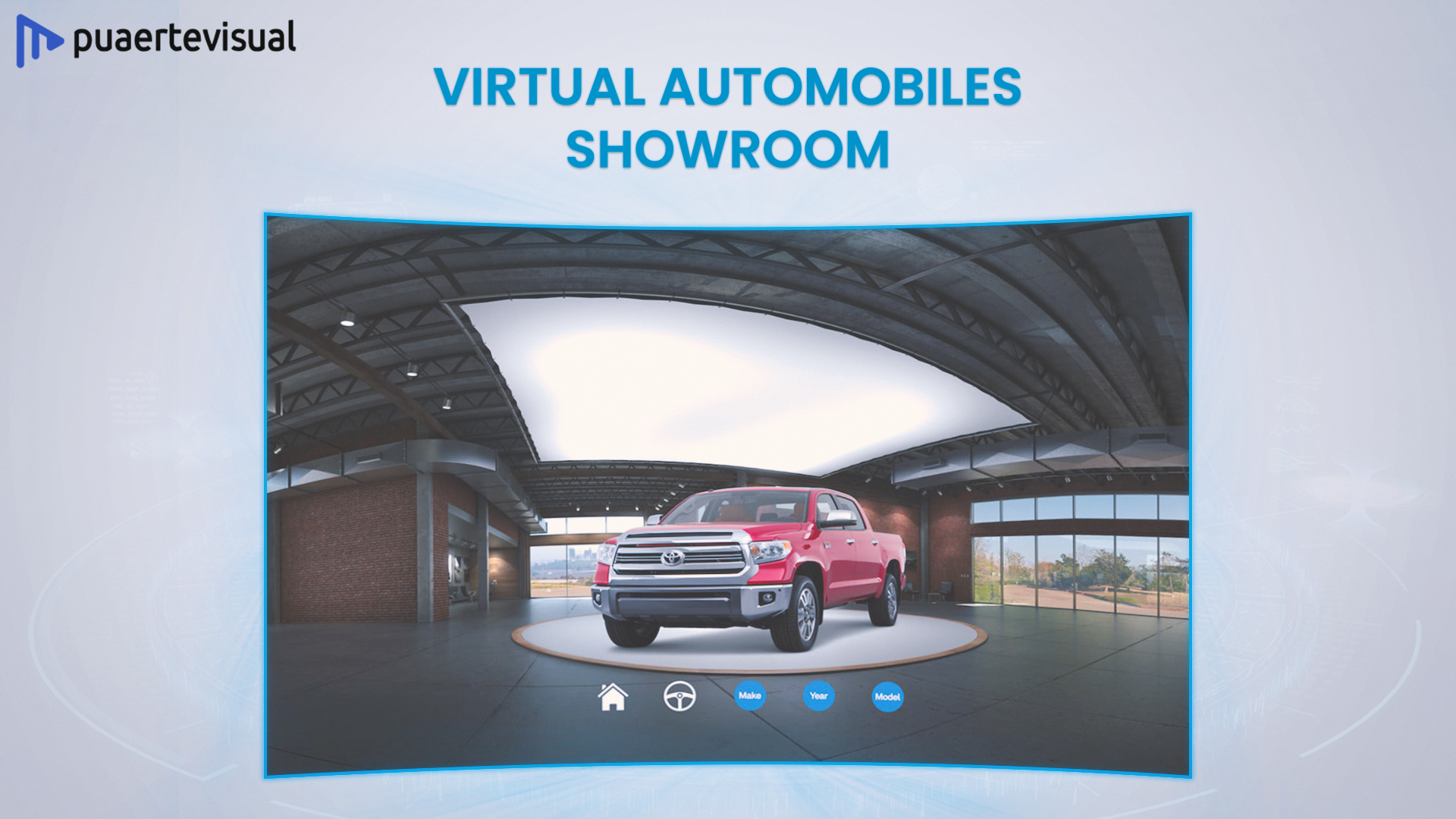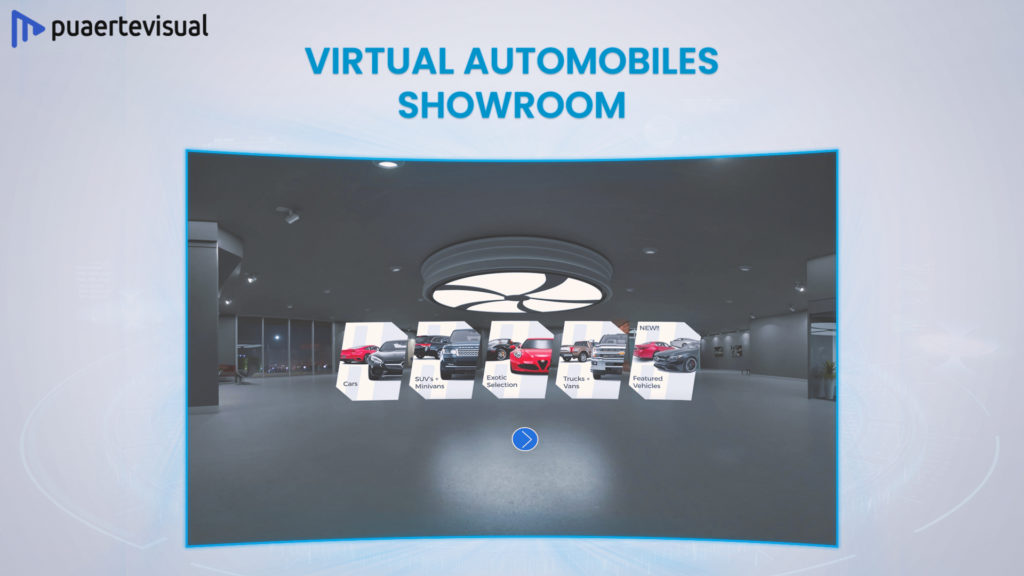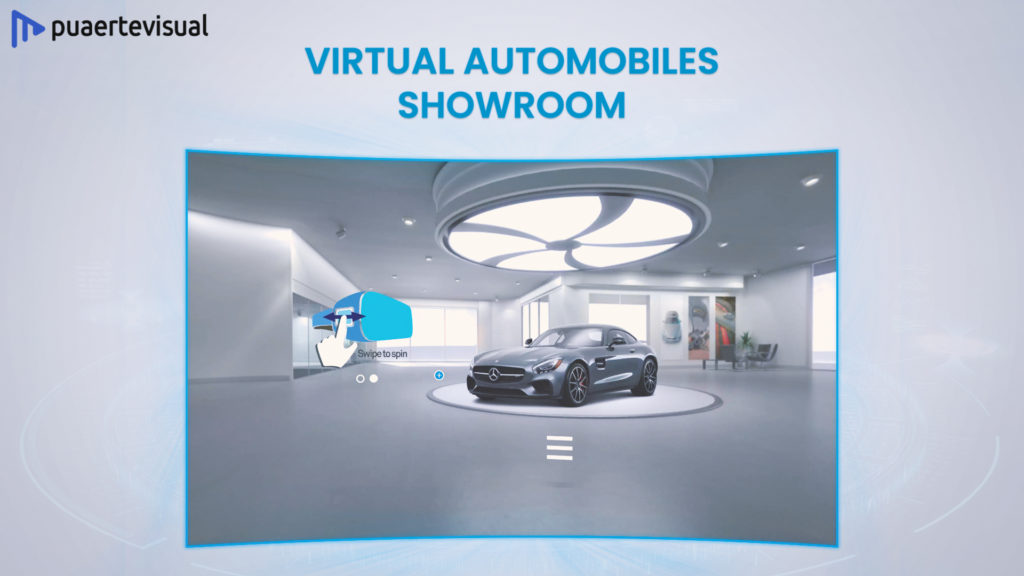
Virtual automobile showrooms research looks at and buys cars from the comfort of home. Buyers can use mobile apps, virtual or augmented reality, and other tools to look at thousands of cars, rotate them, change the paint, “sit” in the driver’s seat, and take virtual test drives.
A virtual car showroom is a way for brands and retailers to use technology to make virtual experiences that let people look at their favorite cars through a VR headset, smartphone, and tablet. Virtual showrooms can be used to make things and show them off. VR helps train employees inside a virtual three-dimensional area that looks like the real thing. It lets car workers practice and improve their skills in a real way without having to worry about making mistakes.

AUTOMOTIVE INDUSTRY TRAINING IN VIRTUAL REALITY
Anything and everything may be experienced in virtual reality (VR). Immersive virtual reality technology can fool the human brain into thinking there is somewhere it isn’t, making it impossible to tell the difference. Using cutting-edge virtual reality technology, we are taking Leap’s hope to deliver virtual reality safety and security training as well as automotive industry training. Both sectors can benefit from our services.
Engineers in the automobile business can be trained in a variety of ways using virtual reality training. Using the virtual reality (VR) training method, staff learn how to build specific models. In addition, virtual reality training in automobile industry facilities allows workers to practice new skills and make mistakes in a safe setting. We work with a number of automobile manufacturers to offer customers the opportunity to see inside and outside of the vehicle, as well as take a short virtual drive. In addition, automotive virtual reality training includes the creation of virtual showrooms where customers can design their own automobiles, for instance, the color of the car.
Today, the self-driving automobile is a significant technological achievement. There’s a lot of overlap between the automobile industry’s virtual reality training and safety and security’s virtual reality training. In the event of an accident, scenarios might be reproduced for the benefit of insurance companies or law enforcement organizations. Additionally, spectators’ eyewitness accounts can be included in a virtual reality simulation of the events. Driver safety is another area where the two areas intersect. Drivers who disregard safety guidelines in the automobile industry are shown what can happen in virtual reality training. Distractions such as texting or conversing on the phone with obnoxious passengers are discouraged in this course.
Why is the vehicle industry interested in using virtual reality (VR) technologies?
Training is a collection of actions designed to orient a new worker or to enhance an employee’s effectiveness in their present position. Staff training that is well-designed boosts employee productivity and loyalty. Finally, it is people who have a direct impact on an enterprise’s financial outcomes. The majority of automakers train their personnel in a consistent manner. Employees receive theoretical training first and then experience operating real-world materials and equipment under supervision.
At the practice stage, personnel are under considerable stress and make errors. Certain errors may be hazardous to the employee or cause equipment damage. Because errors are harmless in the VR world, the student feels relatively secure. The learner may repeat actions quite so many times as necessary within virtual reality software to ensure fluency.
Virtual reality training automobile enables you to safely place trainees in any circumstance and educate them on how to perform optimally in that environment.

What purpose do automakers serve with virtual reality?
Virtual reality has a rich history of being used for training purposes. Today, there are a plethora of established practices and successful application examples. Each project member has access to the virtual project’s history of changes. It enables you to compare alternative solutions, revert to previous versions, or keep developing from a specific point.
Training in vehicle assembly
While traditional training establishes a strong theoretical foundation, it does not prepare assembly employees to master one‘s manual actions. As a consequence, new employees require additional assistance during their transition period. AS a result, numerous automotive manufacturers, including Volkswagen and BMW, are using virtual reality to train their assembly line employees. Automakers can create a safe and controlled learning environment or increase the efficiency of training by utilizing virtual reality. Virtual reality applications educate assembly line workers on how to move ergonomically and safely. Thus, VR training contributes to the reduction of occupational injuries.
Logistics personnel training
Automobile manufacturers’ logistics processes are becoming increasingly complicated as a result of the proliferation of models and the establishment of global supply chains. Numerous processes in logistics remain manual. And businesses suffer losses as a result of logistics employees’ errors. As a result, Audi developed a virtual reality training system to boost logistics employees’ concentration and motivation. Audi VR training passed the testing phase with flying colors and is now being used to optimize packing processes in any Audi plant.
Trainees are immersed in a virtual environment that replicates a real-world logistic center. The program provides guidance on which objects to communicate with and how to interact with them. The trainees manipulate objects with the aid of controllers held in their hands.
The structure of VR training is similar to that of a step-by-step video game, with levels constantly increasing in difficulty. Feedback is given to the trainee at the end of each level. The trainees could repeat levels until they felt competent in their actions. Audi was able to reduce the amount of space and equipment needed to train its logistics staff by utilizing virtual reality training. Employee interest in the work and the implementation of quality standards were both achieved at the same time.
Workers at a dealership are given on-the-job training.
Virtual reality can be used to educate a variety of subjects, including both technical and non-technical skills. In order to enhance sales of automobiles, automotive corporations use virtual reality applications to train their personnel in customer service skills.
A virtual reality training program for dealers was launched by Audi in 2017. There are various sections in the program that teach dealers how and where to sell better, utilize modern sales strategies, how to deliver the best customer service possible, and how to handle customer feedback.
A mood scale for the consumer can be observed by the trainee at any time during the interaction. Interaction success is determined by the level of customer pleasure. Each time the student communicates effectively, they earn points. The totals for each student are summarised in the table below. Employees can thus compare their outcomes with those of other Audi dealerships in Germany as a whole. With the help of virtual reality (VR) training, dealership employees learn how to better serve customers by competing with one another.
Employee training can gain a lot from utilizing VR.
Virtual reality training in automobile sector was once the preserve of the government, the military, as well as the wealthiest corporations until recently. Because of the decrease in the cost of virtual reality gear, it is now accessible to the general public.
As VR gear becomes more widely available as further virtual reality development continues, more businesses will be able to benefit from VR applications.
Here’s a quick rundown of how VR training in the automobile industry might help:
The trainee in virtual reality software is secluded from the actual world, allowing them to concentrate more on the topic. Virtual reality training time and enhances retention.
- Assembling and logistics workers benefit greatly from virtual reality training. Training can be done as many times as necessary in the VR application. You don’t even need any tools or materials for this to stick in your muscle memory.
- Virtual reality (VR) instruction incorporates visual, audio, linguistic, and tactile interactions. As a result, it can be used by people with a variety of learning styles.
- With the use of virtual reality, users can experience a variety of scenarios inside a risk-free setting. There are several ways to practice these tasks, such as using virtual reality.
- There are no geographic restrictions on the use of a conventional virtual reality training program.
- Virtual reality (VR) training raises the level of employee participation. Because of the game-like nature of virtual reality training, employees find it enjoyable. Moreover, it develops a sense of devotion to your organization.
- To optimize your business operations, you may easily assess the trainee’s performance via VR training apps and track bottlenecks.
Thoughts
Training in the automobile sector is being revolutionized by virtual reality. Virtual reality headgear and controllers are being used in place of specialized training centers by large organizations. Virtual reality training automobile can bring benefits at all stages of development, production, and testing of new cars. The automobile industry’s approach to training is being transformed by virtual reality. Specialized training centers are being replaced by virtual reality headgear and controllers in large organizations.
Conclusion
VR makes it possible to train a new employee in a matter of minutes. The personnel are less stressed and more productive as they have already learned how to deal with the workplace environment. As a result, new hires can be trained, old employees can have their skills upgraded, and new hires can be retrained. Using VR apps, co-workers can collaborate on an image in real-time. Shorter interaction times as a result of a reduction in paperwork and bureaucracy It is possible to reap the benefits of virtual reality training provider in Automobile throughout the creation, manufacturing, & testing of new automobiles. With its guidance, you may design any detail or mechanism and construct a fully functional prototype. In fact, you’ll be able to explore more options while spending less money.

Comments are closed.